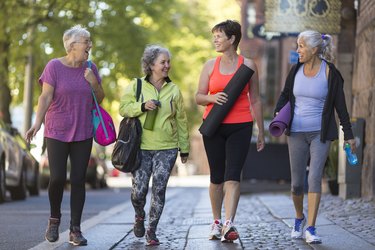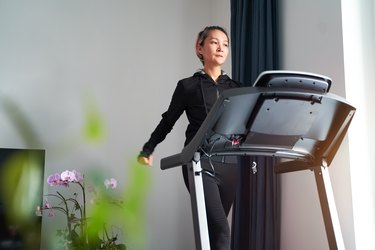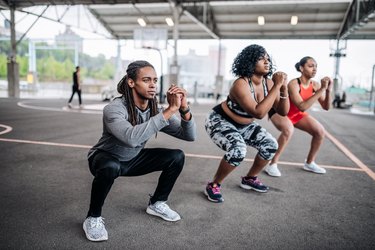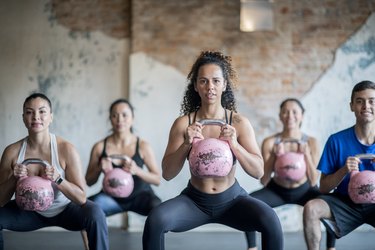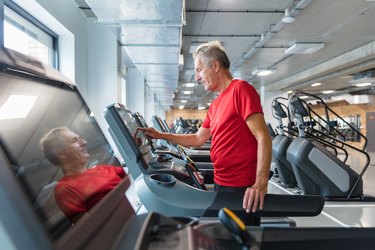
When it comes to exercise, walking is one of the most accessible activities for people of all ages and fitness levels. Walking at a brisk pace has numerous benefits for both physical and mental health. The best part? It's gentle enough on your body to be one of the few workouts you can do every day!
And if you have access to a treadmill — either at home or in the gym — you can walk even when the weather turns nasty. Plus, you're in control of the speed and incline, so you can make it an intense, power-walking workout or an easier active recovery session.
Video of the Day
Tip
Walking for an hour a day on the treadmill can help you lose weight, boost your heart health, reduce stress, lower blood pressure and improve bone health. Just make sure you're walking quickly enough to raise your heart rate above resting and take a 60-minute walk at least three times a week.
Is Walking for an Hour a Day Enough?
If you're ready to start a walking program, you might be wondering how long and how often you need to hit the pavement or the treadmill in order to reap the benefits. While anything is better than nothing, adults should get at least 150 minutes a week of moderate-intensity exercise like walking, according to the U.S. Department of Health and Human Services. That translates to 30 minutes a day, five days a week.
However, that's the bare minimum, and the guidelines suggest that doubling that number to 300 minutes a week (60 minutes, five days a week) yields even greater results. So if you have a big weight-loss, workout or other health goal, walking for one hour on the treadmill can get you closer without putting undue stress on your joints.
But don't stop there! The guidelines also recommend at least two full-body strength-training workouts a week. These sessions can help reduce body fat, strengthen bones, improve balance and enhance athletic performance, according to the American Council on Exercise.
You can accomplish this by hitting the weight room after your treadmill workout or mix it up by alternating between bursts on the treadmill and strength-training exercises (see below for more on treadmill circuit workouts).
Benefits of Walking for an Hour
One of the simplest positive changes you can make to improve your health is to start walking, especially because all it takes is a 30-minute walk five days per week to reap the rewards.
Aerobic exercise such as walking helps lower blood pressure, raise the good HDL cholesterol and lower the bad LDL cholesterol and triglycerides, according to Harvard Health Publishing. It also helps protect against obesity, dementia, osteoporosis and depression. Plus, it helps reduce stress levels and contributes to better sleep.
Walking can also help you lose weight. In order to drop the pounds, though, you need to focus not only on quantity but quality. That means upping the intensity and staying consistent over the long-term.
Tip
Remember: If weight loss is your goal, you need to focus on achieving a caloric deficit — burning more calories than you're consuming. So while walking can help you lose weight, it's only effective if you're eating a health, calorie-reduced diet as well.
Generally speaking, a 154-pound person can burn 280 to 460 calories walking one hour a day on the treadmill or outdoors, according to the Centers for Disease Control and Prevention. That's such a wide range because the actual amount of calories depends on your intensity (and your weight). Translation: The harder you work, the more calories you'll burn, which is the goal for fat loss.
To maximize your caloric burn on the treadmill, consider doing intervals by increasing the pace and incline for a set amount of time (i.e., 2 minutes), followed by a lower workload (slower pace and lower incline) for the same amount of time. Repeat this sequence for 30 to 60 minutes.
A 60-Minute Walking and Strength-Training Workout
As mentioned above, a well-rounded exercise routine needs more than simply walking on the treadmill. If you don't have the time to hit the gym every day, you can combine walking with strength-training exercises for a more efficient workout. To get started, try this sample circuit workout:
One-Hour Treadmill Circuit Workout
- Walk on the treadmill at a moderate pace for three minutes.
- Do 20 walking lunges (video below).
- Walk for another three minutes.
- Get off and do 10 push-ups (video below).
- Walk for three minutes.
- Hold a plank for 30 seconds.
- Repeat this pattern for 30 to 60 minutes while adding other strength-training exercises such as overhead press, biceps curls, triceps kickbacks, squats and chest press (videos below).
Walking Lunge
- Start with your feet together and arms resting comfortably by your sides.
- Step forward with your right foot and lower your body until your front knee is at 90 degrees and your back knee is nearly touching the floor.
- Push off your left leg and step forward, returning to standing.
- Repeat on the opposite leg and continue walking forward in this manner, alternating legs with each step.
Push-Up
- Begin in a high plank, hands directly beneath your shoulders, body in one straight line from toes to hips to head.
- Bending the elbows at a 45-degree angle from the ribs, lower your chest toward the ground.
- Lower until your chest nearly touches the ground.
- On an exhale, extend your arms and return to the high plank.
Tip
If you can't do a full push-up, try doing incline push-ups instead, which are safer and more effective than push-ups on your knees.
Plank
- Lie face-down on the ground with your legs extended. Use your forearms on the ground to push yourself into a plank position, balancing the body.
- Press through your heels to keep your body in a straight line from your heels to hips to head.
- Avoid sinking or hiking the hips. Hold for 30 seconds.
Overhead Press
- Sit or stand tall and hold a dumbbell in each hand at shoulder height with your palms facing forward.
- Push the dumbbells directly upward until your arms straighten and the dumbbells almost touch each other above your head.
- Slowly lower the dumbbells to the starting position.
Tip
Overhead press is a great move to test out lifting heavier weights — push your weight selection here and go for lower reps.
Biceps Curl
- Sit or stand tall and hold a dumbbell in each hand in front of your thighs, with your palms facing up.
- Contract your biceps (upper arm) and lift the weights up to your shoulders, bending at your elbows.
- Lower slowly back down to the start.
Triceps Kickback
- Stand with feet hip-distance apart and knees bent.
- Tilt your torso 45 degrees forward, keeping your spine long.
- Hold a weight in each hand and bend at the elbows to bring your hands toward the shoulders in front of you.
- Straighten your arms back behind you, keeping your shoulders elbows locked in place.
- Lower back to the start with control.
Squat
- Stand with your feet slightly wider than hip-width apart.
- Keeping your back flat, shoulders back and chest out, push your hips back and begin to sit down toward the ground.
- Lower until your thighs are parallel with the ground, pausing for a moment.
- Reverse the motion, pushing the hips forward and return to standing.
Chest Press
- Lie on a flat bench, facing up and gripping a barbell slightly wider than shoulder-width apart.
- Press your feet into the ground and your hips into the bench as you lift the barbell off the rack.
- Slowly lower the barbell to your chest, bending at the elbows.
- Once the barbell reaches chest height and your elbows dip slightly below the bench, press your heels into the ground to raise the barbell back up.
- Return the barbell to starting position, elbows extended but not locked.
- Center for Disease Control and Prevention: "Physical Activity for a Healthy Weight"
- U.S. Department of Health and Human Services: "Physical Activity Guidelines for Americans"
- Harvard Health Publishing: "Walking: Your Steps to Health"
- Harvard Health Publishing: "Exercising to Relax"
- American Council on Exercise: "The Importance of Strength Training as You Age"
Was this article helpful?
150 Characters Max
0/150
Thank you for sharing!
Thank you for your feedback!
